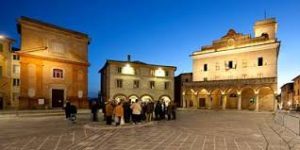Trevi
A 70 Km dal Relais Tenuta del Gallo

Antica cittadina romana lungo la Via Flaminia, Trevi è uno dei borghi più belli d’Italia, famosa per il suo eccellente olio di oliva.
Costruita a cerchi concentrici, il centro è piazza Mazzini, con il suo palazzo Comunale del XIII secolo e la torre Civica. Da qui, costeggiando palazzo Valenti (1545), si raggiunge l’ex convento di San Francesco (XIII secolo) oggi trasformato in complesso museale. Al suo interno si trovano la pinacoteca, il Museo Civico, il Museo della Civiltà dell’Ulivo e la Raccolta d’Arte. La chiesa di San Francesco risale al 1288 e fu modificata nel 1354-58 in forme gotiche. Ha un bel portale e l’interno è a navata unica con tre absidi con volte a crociera, di cui la centrale è poligonale. Vi è custodito un Crocifisso su tavola d’ispirazione giottesca (inizio XIV secolo), opera di uno sconosciuto artista, ricordato appunto come il Maestro del Crocifisso di Trevi. L’abside di destra contiene la stele sepolcrale dell’eremita Beato Ventura, morto nel 1310. Usciti dalla chiesa e proseguendo per via Fantosati si raggiunge la medievale porta del Cieco, da cui si risale lungo via Dogali sino a raggiungere in cima al colle la cattedrale di Sant’Emiliano, costruita tra XII e XIII secolo ma interamente rifatta nel XIX. All’interno spicca l’altare del Sacramento decorato da Rocco di Tommaso nel 1522. Tornati a Porta del Cieco, si volta a sinistra per guadagnare piazza Garibaldi, recentemente restaurata, e da lì raggiungere la panoramica “promenade” di viale Ciuffelli, ombreggiata da alberi secolari per circa un km, che unisce il centro al convento francescano di San Martino (fine XV secolo) dove si trova una cappella affrescata dallo Spagna. Scendendo invece da Trevi verso la via Flaminia in direzione sud, si incontra il rinascimentale santuario della Madonna delle Lagrime, con un bel portale a bassorilievi.
L’interno, a croce latina, conserva i monumenti sepolcrali della famiglia Valenti e nel secondo altare a destra, l’ultima opera del Perugino, L’Adorazione dei Re Magi con i Santi Pietro e Paolo (1521). Scendendo nuovamente per via Dogali, si attraversa l’arco di Mastaccio, un’antica porta nella cerchia delle mura romane e altomedioevali, ad apertura ogivale e sormontata da una bifora. Le case ai due lati della via sono tutte d’impianto medioevale. Molti sono ipalazzi, costruiti tra XV e XVIII secolo, come villa Boemi (XVI secolo), che conferiscono a Trevi la sua particolare atmosfera. Prima di lasciare il borgo merita una visita il teatro Clitunno, della seconda metà del XIX secolo, con un prezioso sipario del Bruschi.


